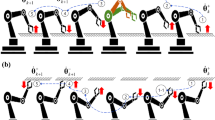Abstract
In this paper, we discuss about multiple coordinated robots that can form a fixtureless manufacturing cell. It is very important to ensure that the system stiffness is sufficient for manufacturing operations when external forces are exerted on the system. For this reason, a method is developed to model and analyze the stiffness of a multiple coordinated robot system. In this paper, first, the stiffness of a multiple coordinated robot system is defined. Similar to a single-arm robot, this definition provides us with a criterion to evaluate the stiffness performance of the entire multiple robot system. Second, a static stiffness model is derived including joint stiffness and link stiffness, and then this model is extended to a multiple robot system. Third, the coordinated static stiffness model is validated, and a comparison is made through simulation between a dual robot system and a single robot system. Finally, the developed model is applied to a real coordinated dual-arm robot system for validation.
Similar content being viewed by others
References
Bone GM, Capson D (2003) Vision-guided fixtureless assembly of automotive components. Robot Comput Integr Manuf 19(1):79–87
Chen Y, Dong F (2013) Robot machining: recent development and future research issues. Int J Adv Manuf Technol 66(9–12):1489–1497
Langley C, D Eleuterio G (2000) Pose estimation for fixtureless assembly using a feature CMAC neural network. International Symposium On Robotics. Citeseer, 356–361
Yu M, Liu HP, Ji J (2012) The collaboration control for the multi-robot polishing system. Adv Mater Res Trans Tech Publ, Switzerland. 1826–1829
Chantranuwathana S, Kananai J (2005) Chanchareon R Development of laser positioning system for fixtureless robotic manufacturing. In: National Science and Technology Development Agency (NSTDA) Annual Conference, 28–30
Cormier D, Harrysson O, Mahale T (2003) Rapid manufacturing in the 21st century. J Chin Inst Ind Eng 20(3):193–203
Gao X, Li B, Hong J, Guo J (2016) Stiffness modeling of machine tools based on machining space analysis. Int J Adv Manuf Technol 86(5–8):2093–2106
Montemayor G, Wen JT (2004) Multiple robot force control with delayed force measurements. IEEE International Conference on Control Applications. IEEE, 327–332
Wen JT, Montemayor G (2005) Stability analysis of decentralized motion and force control for multiple robots. Tech rep, Center for Automation Technologies, 1–7
Montemayor G, Wen JT (2005) Decentralized collaborative load transport by multiple robots. IEEE International Conference on Robotics and Automation (ICRA), IEEE, 372–377
Hayati S (1986) Hybrid position/force control of multi-arm cooperating robots. IEEE International Conference on Robotics and Automation. Pasadena, California, 82–89
Walker ID, Freeman RA, Marcus SI (1991) Analysis of motion and internal loading of objects grasped by multiple cooperating manipulators. Int J Robot Res 10(4):396–409
Liu Z, Chen C, Zhang Y, Chen CP (2015) Adaptive neural control for dual-arm coordination of humanoid robot with unknown nonlinearities in output mechanism. IEEE Trans Cybern 45(3):507–518
Adli MA, Ito K, Hanafusa H (1995) Controlling the contact compliance via internal forces on objects held by dual-arm robots. IEEE/RSJ International Conference on Intelligent Robots and Systems (IROS). Pittsburgh, USA, 62–69
Bicchi A, Prattichizzo D (2000) Manipulability of cooperating robots with unactuated joints and closed-chain mechanisms. IEEE Trans Robot Autom 16(4):336–345
Lephart SM, Pincivero DM, Giraido JL, Fu FH (1997) The role of proprioception in the management and rehabilitation of athletic injuries. Am J Sports Med 25(1):130–137
Funda J, Taylor RH (2001) Method of constrained Cartesian control of robotic mechanisms with active and passive joints. Google Patents
Yu M, An X, Ji J (2013) The study on the communication of the multi-robot polishing system by the ACO mode. Adv Mater Res Trans Tech Publ. 2264–2267
Sánchez G, Latombe J-C (2002) On delaying collision checking in PRM planning: application to multi-robot coordination. Int J Robot Res 21(1):5–26
Schraft R, Neugebauer J, Schaaf W (2000) Quality feature based adjustment of robot programs exemplified for the welding process–. Romansy 13, Vienna, 422:411
Subudhi B, Morris AS (2002) Dynamic modelling, simulation and control of a manipulator with flexible links and joints. Robot Auton Syst 41(4):257–270
Alici G, Shirinzadeh B (2005) Enhanced stiffness modeling, identification and characterization for robot manipulators. IEEE Trans Robot 21(4):554–564
Yan C, Gao F, Ge Q (2010) Compound stiffness modelling of an integrated open-die forging centre with serial–parallel heavy-duty manipulators. Proc Inst Mech Eng B J Eng Manuf 224(12):1841–1853
Guerin D, Caro S, Garnier S, Girin A (2014) Optimal measurement pose selection for joint stiffness identification of an industrial robot mounted on a rail. IEEE/ASME International Conference on Advanced Intelligent Mechatronics (AIM). Besancon, France, 1722–1727
Garg DP, Kumar M (2002) Optimization techniques applied to multiple manipulators for path planning and torque minimization. Eng Appl Artif Intell 15(3):241–252
Liu Y-H, Xu Y, Bergerman M (1999) Cooperation control of multiple manipulators with passive joints. IEEE Trans Robot Autom 15(2):258–267
Xi F, Zhang D, Mechefske CM, Lang SY (2004) Global kinetostatic modelling of tripod-based parallel kinematic machine. Mech Mach Theory 39(4):357–377
Khalil W, Dombre E (2004) Modeling, identification and control of 562 robots. London, UK, 101–105
Sun T, Song Y (2009) Comparison between a 4-DOF hybrid module and Tricept module focusing on inverse kinematics and stiffness. IEEE International Conference on Robotics and Biomimetics (ROBIO). Guilin, Guangxi 1597–1602
Chen S-F, Kao I (2000) Conservative congruence transformation for joint and Cartesian stiffness matrices of robotic hands and fingers. Int J Robot Res 19(9):835–847
Bouyarmane K, Kheddar A (2010) Static multi-contact inverse problem for multiple humanoid robots and manipulated objects. 10th IEEE-RAS International Conference on Humanoid Robots (Humanoids). Nashville, Tennessee, 8–13
Funding
This research work was supported by National Key Technology Support Programme of China (2015BAF10B01), Science and Technology Commission of Shanghai Municipality (15111104002, 15111106302, 16111107802, and 16111108202), Shanghai Training and Support Programme for University Youth Teachers (ZZSD15050), and Innovation Programme of Shanghai Municipal Education Commission (2015Z102800006).
Author information
Authors and Affiliations
Corresponding author
Rights and permissions
About this article
Cite this article
Tian, Y., Wang, B., Liu, J. et al. Stiffness modeling and analysis of a multiple coordinated robot system. Int J Adv Manuf Technol 94, 4265–4276 (2018). https://doi.org/10.1007/s00170-017-1085-4
Received:
Accepted:
Published:
Issue Date:
DOI: https://doi.org/10.1007/s00170-017-1085-4




